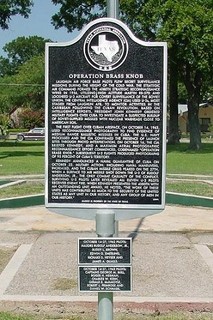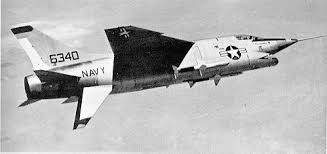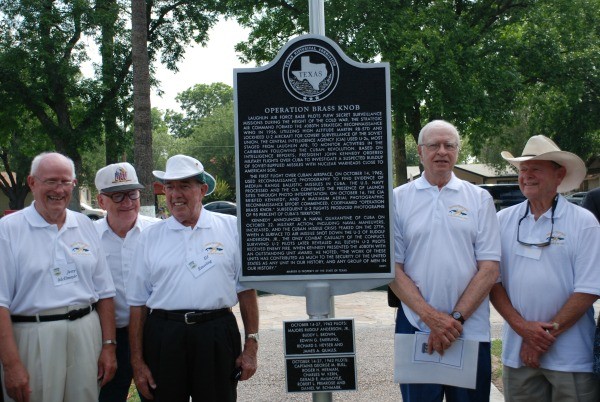Operation Brass Knob
Introduction
Text-to-speech Audio
Images


United States Air Force veterans of the 4080th Strategic Reconnaissance Wing (SRW) stand next to the historical marker for Operation Brass Knob, dedicated in Del Rio, Val Verde County (2008).

Backstory and Context
Text-to-speech Audio
After World War II tensions were high between the United States of America and Russia. Each country just as powerful as the other was in a competition to secure the top spot in the World as a Super Power. This time is referred to as the Cold War, because there was no actual “war” with guns; it was a time when each country built up their Army’s and nuclear weapons. Each country was afraid of the other attacking and would do whatever they needed to do to prevent, stop, and react if they needed to. It was a time where everyone was on their toes to say the least, this is where Operation Brassknob comes into play. There were rumors that Russia had placed nuclear missiles in Cuba, just miles off the coast of the U.S. In order to find the truth the President approved Operation Brassknob and sent U-2 Planes to take pictures over Cuba.
OPERATION BRASS KNOB:
On October 9th of 1962, the 4080th SRW would receive its’ initial orders to prepare for Operation “Brass Knob”, an intensified aerial surveillance of the island of Cuba. With the authority of the President of The United States, the Strategic Air Command would assume this task from the previous tasking of the Central Intelligence Agency. Initially, one flight was approved from south to north over the western end of Cuba, a mission flown by Major Richard S. Heyser on October 14th. Then two more flights were authorized and flown by Major Rudolf Anderson, Jr. and Major Heyser on October 15th. The results of the first mission indicated that total coverage of the island was necessary, and on October 17th, four pilots from Laughlin launched into a terrible thunderstorm and joined Heyser and Anderson in an effort which covered 95% of Cuba. By early November, over one million feet of film had been exposed. All eleven pilots had been fired upon with only one combat casualty, Major Anderson. The Wing would receive the personal plaudits and awards from the President for its’ efforts!
The historical marker reads:
Operation Brass Knob:Laughlin Air Force Base pilots flew secret surveillance missions during the height of the Cold War. The Strategic Air Command formed the 4080th Strategic Reconnaissance Wing in 1956, utilizing high altitude Martin RB-57D and Lockheed U-2 aircraft for covert surveillance of the Soviet Union. The Central Intelligence Agency (CIA) used U-2s, most staged from Laughlin AFB, to monitor activities in the Caribbean following the Cuban Revolution. Based on intelligence reports, President John Kennedy ordered military flights over Cuba to investigate a suspected buildup of Soviet-supplied missiles with nuclear warheads close to American soil. The first flight over Cuban airspace, on October 14, 1962, used reconnaissance photography to find evidence of medium range ballistic missiles in Cuba. The U.S. Navy processed and the CIA confirmed the presence of launch sites through photo interpretation. On October 16, the CIA briefed Kennedy, and a maximum aerial photographic reconnaissance effort commenced, codenamed “Operation Brass Knob.” Subsequent U-2 flights produced photographs of 95 percent of Cuba’s territory.Kennedy announced a naval quarantine of Cuba on October 22. Military action, including naval maneuvers, increased, and the Cuban Missile Crisis peaked on the 27th, when a surface to air missile shot down the U-2 of Rudolf Anderson, Jr., the only combat casualty of the conflict. Surviving U-2 pilots later revealed all eleven U-2 pilots received enemy fire. When Kennedy presented the 4080th with an outstanding unit award, he noted, “The work of these units has contributed as much to the security of the United States as any unit in our history, and any group of men in our history.”
